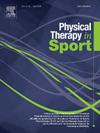年轻艺术、杂技和艺术体操女运动员跟腱、骨和关节疼痛的患病率和相关的身体特征
IF 2.2
3区 医学
Q1 REHABILITATION
引用次数: 0
摘要
目的评估年轻艺术、杂技和艺术体操女运动员肌腱、骨和关节疼痛的患病率,并检查与疼痛相关的身体特征。参与者:体操运动员274名,年龄9-16岁。所有体操运动员的关节、骨骼和肌腱疼痛以及训练影响、人体测量、骨骼特性、肌肉力量和关节活动范围(ROM)均进行了临床评估。结果69.7%的参与者有西班牙症状。与艺术体操运动员相比,艺术体操运动员的肌腱和骨骼疼痛发生率更高(p = 0.011和p = 0.005)。logistic回归分析显示,较高的BMI%和较低的跖屈肌强度与肌腱疼痛有关;BMI%升高、年龄增加、月经初潮、胫骨力量减弱、肌肉力量减弱并伴有骨痛;随着年龄的增长,肌肉力量减少,关节疼痛增加(p <;0.05)。与艺术体操运动员相比,艺术体操运动员和杂技体操运动员的肌腱和关节疼痛风险降低,与艺术体操运动员相比,练习艺术体操运动员的骨骼疼痛风险降低(p <;0.05)。结论年轻女体操运动员在训练过程中出现疼痛的风险较高。身体特征是特定于疼痛类别和体操学科的。在临床上,年轻的体操运动员应该定期进行身体特征和损伤的筛查。本文章由计算机程序翻译,如有差异,请以英文原文为准。
Prevalence and physical features associated with tendon, bone, and joint pain in young artistic, acrobatic, and rhythmic female gymnasts
Objectives
To evaluate the prevalence of tendon, bone, and joint pain, and to examine the physical features associated with pain, in young artistic, acrobatic, and rhythmic female gymnasts.
Design
Cross-sectional.
Participants
274 gymnasts, aged 9–16 years.
Main outcome
All gymnasts were clinically assessed for joint, bone, and tendon pain and for training-impact, anthropometric-measures, bone-properties, muscle-strength, and joint range-of-motion (ROM).
Results
Pain was identified in 69.7 % of the participants. Artistic gymnasts suffered a higher prevalence of tendon and bone pain compared to rhythmic gymnasts (p = 0.011 and p = 0.005, respectively). Logistic-regression showed that greater BMI% and lower plantar-flexor strength were associated with tendon pain; greater BMI%, increased age, menarche, reduced tibial-strength, and reduced muscle strength with bone pain; and, increased age, reduced muscle strength and increased ROM with joint pain (p < 0.05). A reduced risk of tendon and joint pain was found in rhythmic and acrobatic gymnasts compared to artistic gymnasts, and reduced risk of bone pain when practicing rhythmic gymnastics compared to artistic gymnastics (p < 0.05).
Conclusions
Young female gymnasts are at a high risk of developing pain during training. Physical features are specific to pain categories and to gymnastics disciplines. Clinically, young gymnasts should be routinely screened for physical features and for injuries.
求助全文
通过发布文献求助,成功后即可免费获取论文全文。
去求助
来源期刊

Physical Therapy in Sport
医学-康复医学
CiteScore
4.50
自引率
8.30%
发文量
125
审稿时长
39 days
期刊介绍:
Physical Therapy in Sport is an international peer-reviewed journal that provides a forum for the publication of research and clinical practice material relevant to the healthcare professions involved in sports and exercise medicine, and rehabilitation. The journal publishes material that is indispensable for day-to-day practice and continuing professional development. Physical Therapy in Sport covers topics dealing with the diagnosis, treatment, and prevention of injuries, as well as more general areas of sports and exercise medicine and related sports science.
The journal publishes original research, case studies, reviews, masterclasses, papers on clinical approaches, and book reviews, as well as occasional reports from conferences. Papers are double-blind peer-reviewed by our international advisory board and other international experts, and submissions from a broad range of disciplines are actively encouraged.
 求助内容:
求助内容: 应助结果提醒方式:
应助结果提醒方式:


